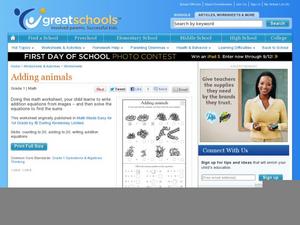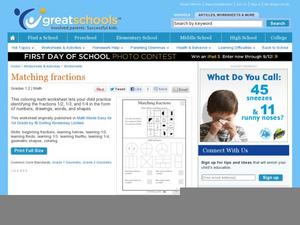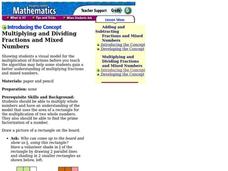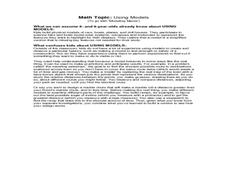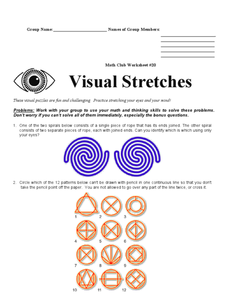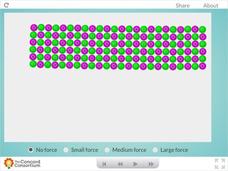Curated OER
Adding Animals
Writing equations from images helps young mathematicians grasp addition, especially when they get to look at cute animals as they do it. There are six number sentences here, each illustrated with a set of animals corresponding to...
Curated OER
Subtracting
Help kids visualize subtraction by assigning these sets of objects for them to subtract. They examine an example before completing the seven equations on their own. For each, learners cross out the subtrahend value and count the...
Curated OER
Fractions of Shapes
Explore fractions visually through segmented shapes. Scholars examine sets of shapes and shade in the given fraction. Each shape is divided into the same number of segments as the denominator of the desired fraction, so beginners aren't...
Curated OER
Matching Fractions
Focus on halves, thirds, and fourths in these visual fraction activities. Scholars begin by examining a grid with various expressions of the three fractions displayed in the grid squares. They color-code the grid to indicate which...
Teachit
Life Cycle of a Penguin
Celebrate the circle of life with this fun hands-on activity. After cutting out, gluing together, and assembling this visual model, learners are able to spin through and observe the life cycle of penguins.
McGraw Hill
Eclipse Interactive
Give your classes a visual model of a rare phenomenon. Learners use an interactive activity to explore the connection of location, tilt, and size to the occurrence of an eclipse. Pupils consider both solar and lunar eclipses throughout...
Curated OER
Multiplying and Dividing Fractions and Mixed Numbers
Help math learners discover how to multiply fractions and mixed numbers. They will explore visual examples of the operations. They also practice solving problems that their instructor models.
University of New Mexico
Visual Supports for Students with Autism Spectrum Disorder (ASD)
Because autism manifests in so many different ways it is referred to as Autism Spectrum Disorder (ASD). No one approach is appropriate for learners with autism. The idea of this packet if to provide a variety of approaches and materials...
American Chemical Society
The Periodic Table and Energy-Level Models
Teach your class to think of electrons as tiny packets of energy that travel in waves. Through a short video and diagram, participants see how electrons are located around the nucleus of an atom. They then get into groups and try to...
Curated OER
Modeling Mania
Students describe techniques helpful in solving spatial problems which utilize the notion that a model is a simplified version of something complicated. They utilize methods such as sketching or drawing possible solutions to a problem.
Curated OER
Math Club Worksheet #30 - Visual Stretches
In this visual math puzzle worksheet, students work in groups to find the answer to 6 math puzzles. They work with geometric shapes and symbols.
Perkins School for the Blind
Chromosome Models- Karyotyping
Create your own karyotypes with clay in a kinesthetic genome activity. This tactile experience was created for visually impaired pupils, but can be used for all hands-on learners who are beginning to study chromosomes. The preparation...
Carnegie Mellon University
Bathtub Model
Using a colorful infographic handout and a guide sheet, hold a class discussion about how a bathtub can serve as a model for the greenhouse effect created by Earth's atmosphere. Participants will understand that as energy or matter is...
National Council of Teachers of Mathematics
The Roll Out Fractions Game: Comparing Fractions
Reinforce the concept of comparing fractions with a hands-on, two-player game that calls for a visual model, score board, and dice. Players roll dice to acquire their given fraction, create the fraction using fraction tiles, then compare...
Melissa Institute for Violence Prevention and Treatment
Concept Muraling
Concept muraling helps learners improve their comprehension of a text by giving them a way to organize their understanding of the key concepts in that text. Introduce readers to this process with a carefully scaffolded instructional...
Laboratory for Atmospheric and Space Physics
Jupiter’s Relative Size
How do you properly illustrate the extreme size difference between two planets—Earth and Jupiter? With the help of jellybeans, of course! Create a scale model of Jupiter's mass compared to Earth using a fishbowl, 1,400 beans, and a dixie...
Kenan
Respiratory System
Explore the respiratory system with a model. First, pupils build a set of lungs to experiment how they inflate and deflate. Then, they delve deeper into the topic with a web quest to discover new information about the nose, trachea, and...
Curated OER
Building a School Model: An Academic Challenge
First and second graders explore aspects of design. They discuss and design the ideal classroom building complete with window and door placement. Additionally, students observe and note features found in neighboring classrooms as...
K-5 Math Teaching Resources
Adding Mixed Numbers (Unlike Denominators)
Mix things things up in your elementary math class with a series of problem-solving exercises. Presented with a series of mixed number word problems, young mathematicians are asked to solve them by using either visual fraction models or...
Concord Consortium
Ceramic Forces
Why are bricks more likely to break than bend? Young science scholars peer inside a ceramic block and examine the effects of downward force at the molecular level. Learners can apply three different levels of force before observing their...
Curated OER
Visual and Meaning Cues
Learn how to apply visual and meaning cues to reading unknown words. Readers will explore what to do when they come to a word they do not know as they watch the teacher model the use of these cues and then participate in guided and...
Dick Blick Art Materials
Peace Windows
Peace, love, tolerance, faith. Marc Chagall's Peace Window in the United Nations World Headquarters serves as a model for young artists as they create their own peace-themed transparent paintings. A great activity for both SPED and...
Brigham Young University
The Presentation
As their final act in a 10-lesson theater arts unit, set designers present their models to the class and explain how their choices of line, color, and texture support the theme they wish to convey.
Pace University
Surrealism
Introduce studio artists to the elements and principles of surrealism with a lesson that includes models of the works of famous surrealists. Class members then select a project from a menu and create their own film, poem, or...


